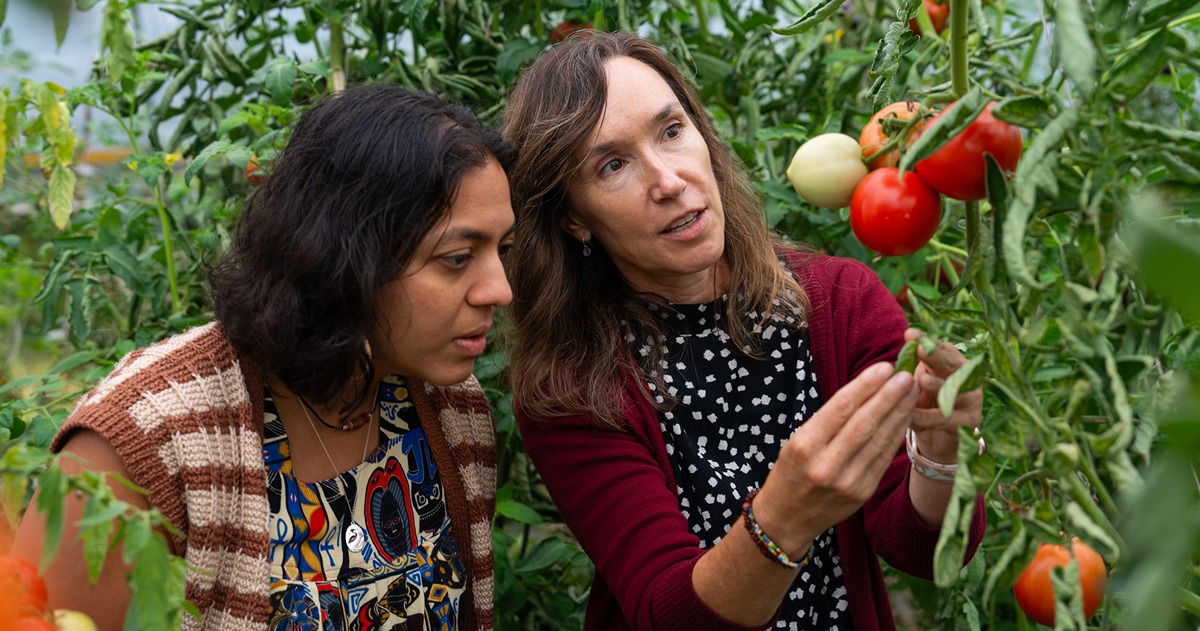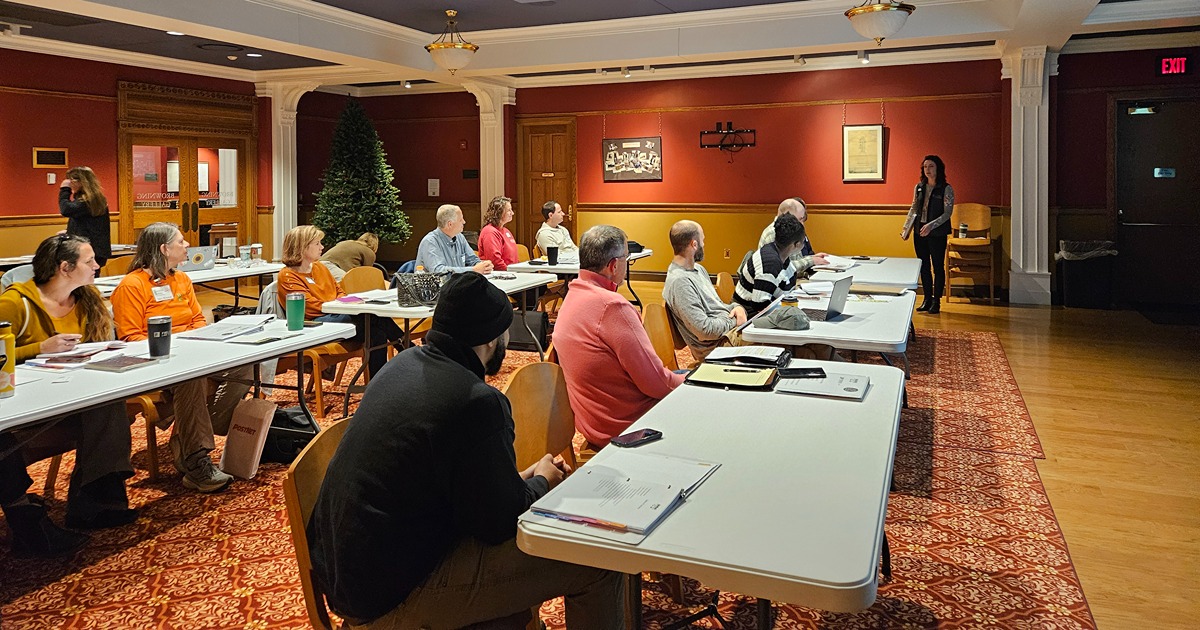Purdue-led TOMI project receives $3.5M grant to turn a decade of data into new tools and strategies for tomato farmers
WEST LAFAYETTE, Ind. — Indiana ranks third in the nation for tomato production. Lori Hoagland, a professor in Purdue University’s Department of Horticulture and Landscape Architecture, recently received a third grant from the U.S. Department of Agriculture’s National Institute of Food and Agriculture (USDA-NIFA) for the Tomato Organic Management and Improvement (TOMI) project, allowing her to focus on sharing data and developing strategies so tomato farmers across the nation can experience similar success.
Hoagland said there are two kinds of tomato production in Indiana. Ketchup and canning companies like Red Gold form the industrial side, which relies on tomato crops grown in large fields. Fresh-market tomatoes, often grown on a small scale to sell unprocessed, may generate less revenue, but they are a fast-growing, popular option for both consumers and growers.
Hoagland came to Purdue 14 years ago with a background in improving the sustainability of farming operations by transitioning from traditional to organic practices in grain, fruit and hop production systems. That experience prepared her to research tomatoes, one of Indiana’s biggest specialty crops. She kicked off TOMI in 2014 by asking farmers what issues they were noticing in their fields. Their overwhelming response was foliar diseases, or diseases on the leaf caused by fungal and bacterial pathogens.
“Specifically, fresh-market growers were concerned about the diseases early blight, late blight and Septoria leaf spot. And so I worked with a team across the United States of people with expertise in organic farming, soil microbial ecology, tomato breeding and pathology to come up with a plan to help overcome this challenge,” Hoagland said.
This team currently consists of researchers and Extension experts from Oregon State University, eOrganic, Organic Seed Alliance, North Carolina State University, University of Hawaiʻi at Mānoa, Virginia State University and University of Wisconsin-Madison. Connecting with organizations and universities across the nation created opportunities for the research to cover regional differences in production.
Originally funded in 2014 and again in 2019 by the USDA-NIFA Organic Agriculture Research and Extension Initiative, the decade of collaboration in TOMI has improved soil health, biocontrol practices, tomato breeding and partnerships with farmers. The $3.5 million grant that Hoagland received this past September emphasizes the development of new tools to use this data and on-farm trials to test them.
Hoagland’s lab team has looked back to the wild ancestors of tomato plants from South America to better understand the genetics of the crop and find lost traits that would be useful for modern varieties, like disease resistance. The team found that, even though these wild ancestors do not produce big or flavorful tomatoes like modern varieties, they form beneficial relationships with microbial populations in the soil that help them fight pathogens.
“There is a small cost to the plants when they form these microbe associations. Plants give away carbon to then get protection from pests or obtain nutrients from these microbes,” Hoagland explained. “When you domesticate a plant, you’re selecting under very high-input conditions. So, it looks like some modern plants may have shut those microbial relationships down because they don’t need it when they are fed lots of nutrients and treated with lots of chemicals.”
The TOMI team is finding markers in the genomes of these wild ancestors that correspond to greater microbial associations. Then, with selective breeding, they are bringing that trait and others back into modern tomato plants. Some advanced lines from their breeding program are already in trial with organic seed companies.
Through the first two phases and continuing in the third, the TOMI team has engaged in participatory plant breeding. This practice puts the generation of new tomato varieties in the hands of local farmers and customers. With help from researchers, farmers select the plants that best suit their soil, climate and management style. Chefs test which tomatoes work well in their favorite dishes, and consumers buy and pay the most for the best taste and texture. By hearing these voices, the TOMI team has given control of new tomato varieties to every stakeholder, building local supply chains and increasing the regional success of the crop.
While Hoagland believes this preventative measure is the best option for strengthening the plants’ defense against foliar pathogens, the TOMI team is also testing different organisms to find effective biocontrol agents. Biocontrol, or using one organism to control another, is possible because of complex interactions of microbes in the soil and on leaves — both places where biocontrol agents can be applied. Microbes can work together or against each other in competition for resources. Adding or removing just one population of microbes to the system can trigger domino effects for the rest of the microbiome.
Hoagland said they are working to understand how to promote the survival of these biocontrol agents and enhance their natural populations in soil. “Moving forward in this next phase, we will be using some bacillus species as a model to understand why and how they survive in different environments,” she said.
Since the first two phases of TOMI, weather patterns, scientific research and the production of tomatoes have all experienced change. Where late blight was a major problem in 2014, gray mold now causes more damage in the increasingly popular high tunnels — an affordable hybrid of greenhouse and field production that extends growing seasons. TOMI researchers have had to adapt their strategies and practices to keep pace with these changes.
One of the major objectives for this next phase is to make TOMI data useful for farmers moving forward and flexible enough to keep up with a continuously changing climate. Assistant professor Ankita Raturi of the Department of Agricultural and Biological Engineering is taking the massive amount of data and distilling it into tools that growers can use to help inform their farm management decisions. She will do this by training machine learning models, a subset of artificial intelligence that can find and analyze patterns in data to predict certain outcomes, like yield under various weather and disease conditions.
“Our design challenge revolves around creating user-friendly digital tools that leverage high-quality research datasets,” Raturi said. “We want to provide farmers and other decision-makers with the right data, in the right place and at the right time to support action! That’s both short-term, tactical decision support around disease management, as well as more strategic support for farm-specific variety selection.”
With those decision-support tools, Hoagland and the rest of the TOMI team are looking forward to interacting more with farmers. They are taking their research to the field and working with producers to test their new tomato varieties and biocontrol applications.
Hoagland said these on-farm trials are the most meaningful part of her work. “Here at the university, we have a lot of knowledge, but the farmers are seeing things that I would never see. They are constantly experimenting and have really good ideas. They may not have the science to understand the phenomenon that’s happening or know how to replicate it — that’s where a scientist can come in and help them. It really is a joint collaboration to develop solutions moving forward.”
Also in this latest phase of the project, TOMI will emphasize outreach and inclusion. Hoagland and her collaborators realized that their research was being found and used by growers with ties to land-grant universities, but less so by those without those connections. TOMI will be creating new support networks, hosting seminars and producing Extension publications to help organic farmers, Extension educators, researchers, students, chefs and consumers connect. From production to taste, the TOMI team is engaging in community participatory research and fostering new marketing relationships for their novel tomato varieties.
Even after a decade on the project, Hoagland is energized by her research and collaborators. Her favorite part has been watching her students learn and grow. From one student publishing a paper and being approached by general audiences and the press alike, to another becoming a professor at the University of Hawaiʻi at Mānoa, Hoagland measures her success by watching her lab members flourish and help farmers, in tomatoes and beyond.
“Developing more sustainable production systems will help all growers,” Hoagland said.
About Purdue Agriculture
Purdue University’s College of Agriculture is one of the world’s leading colleges of agricultural, food, life and natural resource sciences. The college is committed to preparing students to make a difference in whatever careers they pursue; stretching the frontiers of science to discover solutions to some of our most pressing global, regional and local challenges; and, through Purdue Extension and other engagement programs, educating the people of Indiana, the nation and the world to improve their lives and livelihoods. To learn more about Purdue Agriculture, visit this site.
About Purdue University
Purdue University is a public research university leading with excellence at scale. Ranked among top 10 public universities in the United States, Purdue discovers, disseminates and deploys knowledge with a quality and at a scale second to none. More than 106,000 students study at Purdue across multiple campuses, locations and modalities, including more than 57,000 at our main campus locations in West Lafayette and Indianapolis. Committed to affordability and accessibility, Purdue’s main campus has frozen tuition 14 years in a row. See how Purdue never stops in the persistent pursuit of the next giant leap — including its integrated, comprehensive Indianapolis urban expansion; the Mitch Daniels School of Business; Purdue Computes; and the One Health initiative — at https://www.purdue.edu/president/strategic-initiatives.
Writer: Lindsey Berebitsky, lberebit@purdue.edu, 765-749-5296
Media contact: Devyn Ashlea Raver, draver@purdue.edu
Sources: Lori Hoagland, lhoaglan@purdue.edu; Ankita Raturi, ankita@purdue.edu
Agricultural Communications: Maureen Manier, mmanier@purdue.edu, 765-494-8415
Journalist Assets: Images and/or Videos, Google Drive






